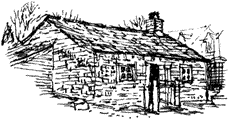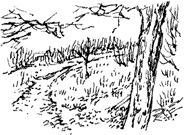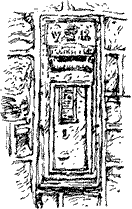Richard Bell's Wild West Yorkshire nature diary
Larks on the Sabbath
‹previous
| this month | home
page | e-mail me | next›
 Tuesday,
2nd January, 2007
Tuesday,
2nd January, 2007
THIS MORNING I'm drawing (again from one of my photographs)
this small stable store at Ossett Spa which I passed on the
Lupset (right, below) walk that I devised for my booklet.
The building was recently restored. As you'd guess from the chimney, it has
a fireplace at one end. My guess is that it was originally built as a cottage.
 In
a survey of the working conditions of local miners made in 1841 the inspectors
describe whole families living in cottages no larger than this; mum and dad
and perhaps 4 children (some of whom also worked in the colliery) lived in two
small rooms. The report gives a rare look at the lives of ordinary people. The
inspectors record the furniture and even the books - invariably a bible or prayer
book - which they found in each house.
In
a survey of the working conditions of local miners made in 1841 the inspectors
describe whole families living in cottages no larger than this; mum and dad
and perhaps 4 children (some of whom also worked in the colliery) lived in two
small rooms. The report gives a rare look at the lives of ordinary people. The
inspectors record the furniture and even the books - invariably a bible or prayer
book - which they found in each house.
Joseph Charlesworth, a collier from Flockton came in for criticism:
'His house is rather close, the light and air being much impeded by the cages
of six larks being hung in the small window.
'This person is a good and regular worker, but extremely negligent of his religious
duties, spending the Sabbath smoking and feeding his birds.'
Joseph's house was even smaller than the Ossett Spa cottage; the 'House' (living
room) was 6 x 4ft, the bedroom 5 x 3.5. He and his wife Anne had four children,
aged from 3 to 9. The eldest, George was already working as a hurrier (carrying
coal underground) and earning four shillings a week.
 Victorian
Postbox
Victorian
Postbox
I like to point out details of history and natural history along the way, although
I won't be able to go into details in the context of a walks book.
I couldn't resist including this Victorian postbox which is
a rare survival. It is built into the end wall of a house at Hall Cliffe, Horbury.
I have vague memories of this house, Manor View, having been a corner shop in
the 1960s.
Link: my booklet Coxley
Valley includes a couple of pages on the 1841 report.
‹previous
| this month | home
page | e-mail me | next›
 Tuesday,
2nd January, 2007
Tuesday,
2nd January, 2007 In
a survey of the working conditions of local miners made in 1841 the inspectors
describe whole families living in cottages no larger than this; mum and dad
and perhaps 4 children (some of whom also worked in the colliery) lived in two
small rooms. The report gives a rare look at the lives of ordinary people. The
inspectors record the furniture and even the books - invariably a bible or prayer
book - which they found in each house.
In
a survey of the working conditions of local miners made in 1841 the inspectors
describe whole families living in cottages no larger than this; mum and dad
and perhaps 4 children (some of whom also worked in the colliery) lived in two
small rooms. The report gives a rare look at the lives of ordinary people. The
inspectors record the furniture and even the books - invariably a bible or prayer
book - which they found in each house. Victorian
Postbox
Victorian
Postbox